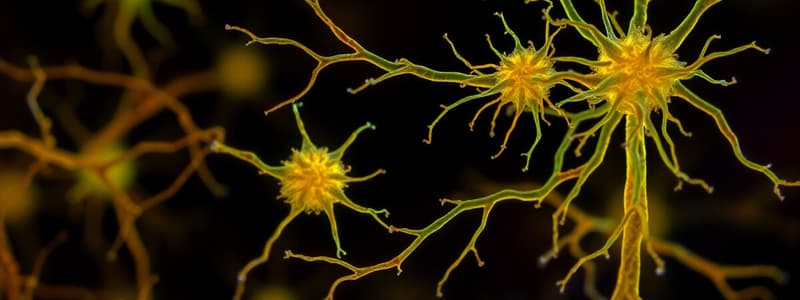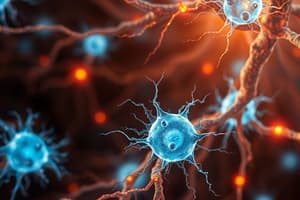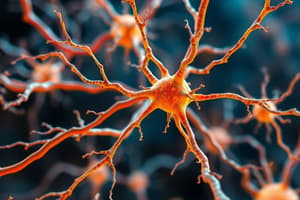Podcast
Questions and Answers
Which type of neuroglial cell in the peripheral nervous system is responsible for forming a myelin sheath?
Which type of neuroglial cell in the peripheral nervous system is responsible for forming a myelin sheath?
- Schwann Cells (correct)
- Oligodendrocytes
- Microglia
- Astrocytes
What is the primary function of astrocytes in the central nervous system?
What is the primary function of astrocytes in the central nervous system?
- Removing waste products from the neurons
- Forming myelin sheaths
- Nourishing neurons and providing structural support (correct)
- Conducting electrical impulses
What distinguishes oligodendrocytes from Schwann cells?
What distinguishes oligodendrocytes from Schwann cells?
- Oligodendrocytes form myelin sheaths in the peripheral nervous system.
- Oligodendrocytes provide structural support for neurons.
- Oligodendrocytes are only found in the spinal cord.
- Oligodendrocytes can form myelin sheaths for multiple axons. (correct)
Which of the following statements about neuroglial cells is correct?
Which of the following statements about neuroglial cells is correct?
What type of neuron carries impulses from peripheral body parts to the central nervous system?
What type of neuron carries impulses from peripheral body parts to the central nervous system?
Which of the following best describes the resting potential of a neuron?
Which of the following best describes the resting potential of a neuron?
How do Schwann cells contribute to nerve impulse transmission?
How do Schwann cells contribute to nerve impulse transmission?
Which type of neuroglial cell is primarily involved in removing waste products from neurons in the central nervous system?
Which type of neuroglial cell is primarily involved in removing waste products from neurons in the central nervous system?
What occurs during an excitatory postsynaptic potential?
What occurs during an excitatory postsynaptic potential?
What is the role of inhibitory postsynaptic potential in action potential generation?
What is the role of inhibitory postsynaptic potential in action potential generation?
What type of neurotransmitter modification do monoamines undergo?
What type of neurotransmitter modification do monoamines undergo?
What characterizes the divergence of a neuron?
What characterizes the divergence of a neuron?
Which fibers exclusively contain sensory fibers?
Which fibers exclusively contain sensory fibers?
Which part of the reflex arc carries impulses away from the central nervous system?
Which part of the reflex arc carries impulses away from the central nervous system?
What is one function of astrocytes in the nervous system?
What is one function of astrocytes in the nervous system?
What is the primary function of oligodendrocytes?
What is the primary function of oligodendrocytes?
Which type of neuroglial cell is responsible for forming the myelin sheath in the central nervous system?
Which type of neuroglial cell is responsible for forming the myelin sheath in the central nervous system?
What role do astrocytes play in the nervous system?
What role do astrocytes play in the nervous system?
What is the primary function of the presynaptic fiber in synaptic transmission?
What is the primary function of the presynaptic fiber in synaptic transmission?
What occurs when neurotransmitters bind to receptors on the postsynaptic membrane?
What occurs when neurotransmitters bind to receptors on the postsynaptic membrane?
Which cells form clusters of neuron cell bodies in the peripheral nervous system?
Which cells form clusters of neuron cell bodies in the peripheral nervous system?
In the context of nerve impulses, what condition must be met for the transmission of a signal along a neuron's membrane?
In the context of nerve impulses, what condition must be met for the transmission of a signal along a neuron's membrane?
What distinguishes unmyelinated fibers from myelinated fibers?
What distinguishes unmyelinated fibers from myelinated fibers?
Why is regeneration of neurons limited in the central nervous system?
Why is regeneration of neurons limited in the central nervous system?
What is the primary function of sensory neurons in the nervous system?
What is the primary function of sensory neurons in the nervous system?
Which statement accurately describes the direction of impulse transmission in a neuron?
Which statement accurately describes the direction of impulse transmission in a neuron?
What is a characteristic of unipolar neurons?
What is a characteristic of unipolar neurons?
Which of the following describes the role of neuroglial cells in the nervous system?
Which of the following describes the role of neuroglial cells in the nervous system?
What distinguishes motor (efferent) neurons from other types of neurons?
What distinguishes motor (efferent) neurons from other types of neurons?
Flashcards
Central Nervous System (CNS)
Central Nervous System (CNS)
Consists of the brain and spinal cord.
Peripheral Nervous System (PNS)
Peripheral Nervous System (PNS)
All nerves extending from the CNS to the body.
Sensory Function
Sensory Function
Detecting changes and sending impulses to CNS.
Integration Function
Integration Function
Signup and view all the flashcards
Motor Function
Motor Function
Signup and view all the flashcards
Neurons
Neurons
Signup and view all the flashcards
Neuroglia
Neuroglia
Signup and view all the flashcards
Cell Body (Neuron)
Cell Body (Neuron)
Signup and view all the flashcards
Dendrites
Dendrites
Signup and view all the flashcards
Axon
Axon
Signup and view all the flashcards
Multipolar Neuron
Multipolar Neuron
Signup and view all the flashcards
Bipolar Neuron
Bipolar Neuron
Signup and view all the flashcards
Unipolar Neuron
Unipolar Neuron
Signup and view all the flashcards
Sensory Neuron
Sensory Neuron
Signup and view all the flashcards
Motor Neuron
Motor Neuron
Signup and view all the flashcards
Schwann Cells
Schwann Cells
Signup and view all the flashcards
Myelinated Fibers
Myelinated Fibers
Signup and view all the flashcards
Unmyelinated Fibers
Unmyelinated Fibers
Signup and view all the flashcards
Synapse
Synapse
Signup and view all the flashcards
Resting Potential
Resting Potential
Signup and view all the flashcards
Action Potential
Action Potential
Signup and view all the flashcards
Saltatory Conduction
Saltatory Conduction
Signup and view all the flashcards
Study Notes
Divisions of the Nervous System
- The nervous system is divided into two main parts: the central nervous system (CNS) and the peripheral nervous system (PNS).
- The CNS consists of the brain and spinal cord.
- The PNS consists of all nerves that extend from the CNS to the rest of the body.
General Functions of the Nervous System
- The nervous system has 3 general functions: sensory, integration, and motor.
- Sensory nerves detect internal and external changes, and carry impulses to the CNS.
- Integration involves processing the sensory input by the CNS to make decisions.
- Motor nerves carry impulses from the CNS to effectors, which are muscles or glands that respond to the signals.
Cells of the Nervous System
- The nervous system is made up of two main types of cells: neurons and neuroglia.
- Neurons are the main functional cells of the nervous system, responsible for conducting impulses, and they are responsible for communication.
- Neuroglia are supporting cells that provide framework, nourishment, and protection for neurons They do not conduct impulses, but have supporting roles.
Neurons
- Neurons have three main parts: a cell body, dendrites, and an axon.
- Cell Body: Contains the nucleus and other organelles, producing proteins and neurotransmitters.
- Dendrites: Receive input and carry impulses toward the cell body. Can be multiple.
- Axon: Transmits impulses away from the cell body, usually a single long fiber.
- Impulses travel from dendrites to cell body to axon in one direction.
Neuron Classification
-
Structural Classification:
- Multipolar neurons: One axon and multiple dendrites.
- Bipolar neurons: One axon and one dendrite.
- Unipolar neurons: One process that splits into two branches: a peripheral (sensory) process and a central process.
-
Functional Classification:
- Sensory (afferent) neurons: Carry impulses from peripheral body parts to the CNS.
- Interneurons: Located within the CNS, form links between other neurons, relaying signals for complex functions.
- Motor (efferent) neurons: Carry impulses from the CNS to effectors (muscles or glands).
Neuroglia
-
Types in the PNS:
- Schwann cells: Produce myelin on myelinated neurons. They can wrap tightly around axons forming a myelin sheath with a neurilemma (outermost layer with cytoplasm and nucleus). They can also provide only a neurilemma with no myelin sheath.
- Satellite cells: Small cells that surround neuron cell bodies in groups called ganglia.
-
Types in the CNS:
- Astrocytes: Large star-shaped cells that provide structural support, communication, and transport between blood vessels and neurons.
- Oligodendrocytes: Similar to astrocytes but with fewer processes, they form myelin sheaths in the CNS, but without a neurilemma.
- Microglia: Small cells with few processes, found throughout the CNS, providing structural support and phagocytosis ( engulfing debris).
- Ependyma: Cuboidal and columnar cells lining the cavities of the brain and spinal cord, helping to produce and circulate cerebrospinal fluid.
Myelinated vs. Unmyelinated Fibers
- Myelinated fibers: Have a myelin sheath, which is a fatty covering around an axon, enabling faster impulse conduction.
- Unmyelinated fibers: Lack a myelin sheath, leading to slower impulse transmission.
- Gray matter: Nervous tissue with many cell bodies and unmyelinated fibers.
- White matter: Nervous tissue with many myelinated fibers, forming bundles called tracts.
Neuron Regeneration
- CNS: No regeneration, due to the absence of an endoneurial tube and neurilemma.
- PNS: Regeneration is possible, since the presence of the endoneurium may prevent scar tissue formation and allows the neuron process to regrow.
- Destruction of the cell body in either CNS or PNS prevents any regeneration.
Synapse
- A junction between the axon of one neuron and the dendrite or cell body of another neuron, allowing communication between neurons.
- Two parts of a synapse:
- Presynaptic fiber: The neuron sending the impulse, releasing neurotransmitters into the synaptic cleft (the space between neurons).
- Postsynaptic fiber: The neuron receiving the impulse, possessing receptors for neurotransmitters.
Synaptic Transmission
- Steps involved in synaptic transmission:
- Presynaptic knob contains vesicles filled with neurotransmitters.
- When an impulse reaches the knob, calcium ions (Ca++) diffuse into the cytoplasm.
- Vesicles move to the membrane and release neurotransmitters into the synaptic cleft.
- Neurotransmitters cross the cleft and bind to receptors on the postsynaptic membrane.
- If enough neurotransmitters are present, an action potential occurs in the postsynaptic neuron.
- Neurotransmitters are either decomposed or reabsorbed back into the presynaptic knob, stopping the signal.
Neuron Potentials
- A nerve impulse is a series of permeability changes along a neuron's membrane, caused by changes in the concentration of ions on either side of the membrane.
Resting Potential
- The charge distribution when a nerve is not conducting an impulse. A nerve at rest has very low permeability to potassium (K+) and even lower permeability to sodium (Na+).
- Active transport pumps are required to maintain this imbalance, pumping K+ in and Na+ out, creating an uneven charge across the membrane.
- The inside is more negative, creating a potential difference where positive charges are attracted to the inside (more Na+ on the outside, K+ inside).
- The outside of the membrane is positive relative to the inside.
Changes in Potentials
- When a stimulus encounters a neuron, it affects the permeability of the neuron's membrane to ions, changing the potential:
- Hyperpolarization: The resting membrane becomes more negative.
- Depolarization: The resting membrane becomes more positive.
Nerve Impulse
- If a stimulus is strong enough (threshold), it causes sodium (Na+) gates to open.
- Na+ flows into the cell, depolarizing the membrane.
- Action potential: When the membrane reaches +30 mV, caused by a rapid influx of Na+ ions. Triggers a chain reaction of action potentials down the neuron.
Repolarization
- Potassium (K+) gates open: K+ diffuses out of the cell, repolarizing the membrane.
- Brief hyperpolarization occurs (below -70 mV), as more K+ leaves than needed to regain neutrality.
Active Transport
- The active transport pumps reestablish the resting potential by pumping Na+ out and K+ in.
- The active transport requires energy to maintain the balance of ions.
Terms related to Nerve Impulses
- All-or-none response: If a neuron responds, it responds completely, conducting the impulse fully, or not at all.
- Refractory period: A short time after an impulse, where the neuron cannot respond to another stimulus.
- Saltatory conduction: Type of impulse conduction along myelinated fibers. The impulse jumps from node to node (which are gaps in the myelin sheath). This makes conduction faster than in unmyelinated fibers.
Speed of Nerve Impulse
- Thick fibers conduct faster than thin fibers.
- Myelinated fibers conduct faster than unmyelinated fibers.
- Fastest: thick and myelinated fibers.
- Slowest: thin and unmyelinated fibers.
Synaptic Potentials
- Changes in voltage in localized areas of the dendrite or cell body caused by neurotransmitters.
- Two types:
- Excitatory postsynaptic potential (EPSP): Neurotransmitter triggers Na+ gates to open, depolarizing the membrane. Makes it more likely for an action potential to occur.
- Inhibitory postsynaptic potential (IPSP): Neurotransmitter triggers K+ gates to open, hyperpolarizing the membrane. Makes it less likely for an action potential to occur.
Integration of Synaptic Potentials
- Multiple synaptic knobs can contact a single neuron.
- The summation of excitatory and inhibitory effects decides whether an action potential is triggered.
- Facilitation: If a neuron receives a net excitatory stimulation, but is below threshold, it becomes more susceptible to an action potential later.
Types of Neurotransmitters
- Monoamines: Modifications of amino acids (e.g., epinephrine, dopamine, serotonin).
- Amino acids: Unmodified amino acids (e.g., glycine, GABA).
- Peptides: Short chains of amino acids (e.g., substance P, endorphins).
Nervous System Convergence
- A neuron receives impulses from two or more other neurons.
- Allows the brain to receive information from different regions and respond in a specific way.
Nervous System Divergence
- One neuron sends impulses to two or more other neurons.
- The response is amplified.
Nerve Classification
-
Types of fibers:
- Sensory fibers: (afferent) Only carry sensory impulses.
- Motor fibers: (efferent) Only carry motor impulses.
- Mixed fibers: Carry both sensory and motor impulses.
-
Origin:
- Cranial nerves: Originate from the brain.
- Spinal nerves: Originate from the spinal cord.
Groups of General Nerve Fibers
- General Somatic Efferent Fibers: Carry impulses from the CNS to skeletal muscles.
- General Visceral Efferent Fibers: Carry impulses from the CNS to smooth muscles and glands.
- General Somatic Afferent Fibers: Carry impulses from skeletal muscles and skin to the CNS.
- General Visceral Afferent Fibers: Carry impulses from smooth muscles and glands to the CNS.
Reflex Arc
- A simple impulse pathway used in reflexes (automatic responses to a stimulus):
- Receptor: Specialized nerve endings that detect the stimulus.
- Sensory neuron: Carries the impulse from the receptor to the CNS.
- Interneuron: Connects the sensory neuron to the motor neuron.
- Motor neuron: Carries the impulse from the CNS to the effector.
- Effector: Smooth muscle or gland that responds.
Studying That Suits You
Use AI to generate personalized quizzes and flashcards to suit your learning preferences.




